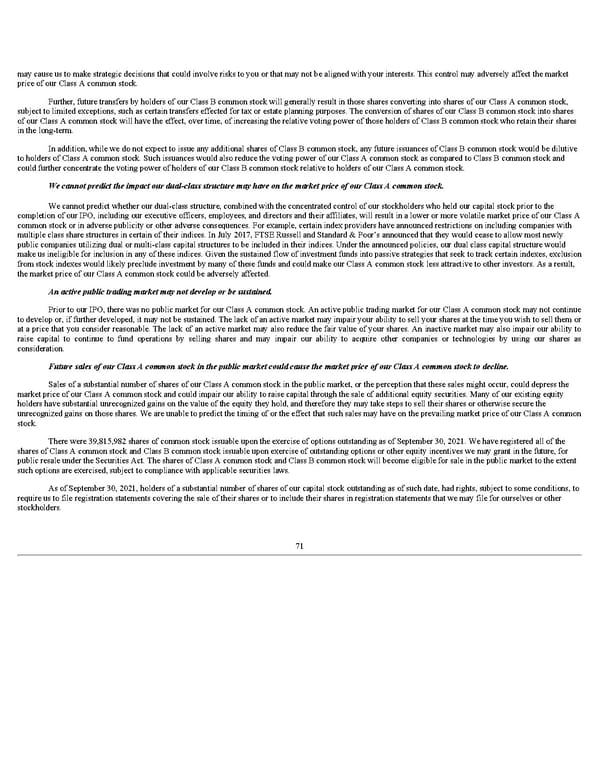may cause us to make strategic decisions that could involve risks to you or that may not be aligned with your interests. This control may adversely affect the market price of our Class A common stock. Further, future transfers by holders of our Class B common stock will generally result in those shares converting into shares of our Class A common stock, subject to limited exceptions, such as certain transfers effected for tax or estate planning purposes. The conversion of shares of our Class B common stock into shares of our Class A common stock will have the effect, over time, of increasing the relative voting power of those holders of Class B common stock who retain their shares in the long-term. In addition, while we do not expect to issue any additional shares of Class B common stock, any future issuances of Class B common stock would be dilutive to holders of Class A common stock. Such issuances would also reduce the voting power of our Class A common stock as compared to Class B common stock and could further concentrate the voting power of holders of our Class B common stock relative to holders of our Class A common stock. We cannot predict the impact our dual-class structure may have on the market price of our Class A common stock. We cannot predict whether our dual-class structure, combined with the concentrated control of our stockholders who held our capital stock prior to the completion of our IPO, including our executive officers, employees, and directors and their affiliates, will result in a lower or more volatile market price of our Class A common stock or in adverse publicity or other adverse consequences. For example, certain index providers have announced restrictions on including companies with multiple class share structures in certain of their indices. In July 2017, FTSE Russell and Standard & Poor’s announced that they would cease to allow most newly public companies utilizing dual or multi-class capital structures to be included in their indices. Under the announced policies, our dual class capital structure would make us ineligible for inclusion in any of these indices. Given the sustained flow of investment funds into passive strategies that seek to track certain indexes, exclusion from stock indexes would likely preclude investment by many of these funds and could make our Class A common stock less attractive to other investors. As a result, the market price of our Class A common stock could be adversely affected. An active public trading market may not develop or be sustained. Prior to our IPO, there was no public market for our Class A common stock. An active public trading market for our Class A common stock may not continue to develop or, if further developed, it may not be sustained. The lack of an active market may impair your ability to sell your shares at the time you wish to sell them or at a price that you consider reasonable. The lack of an active market may also reduce the fair value of your shares. An inactive market may also impair our ability to raise capital to continue to fund operations by selling shares and may impair our ability to acquire other companies or technologies by using our shares as consideration. Future sales of our Class A common stock in the public market could cause the market price of our Class A common stock to decline. Sales of a substantial number of shares of our Class A common stock in the public market, or the perception that these sales might occur, could depress the market price of our Class A common stock and could impair our ability to raise capital through the sale of additional equity securities. Many of our existing equity holders have substantial unrecognized gains on the value of the equity they hold, and therefore they may take steps to sell their shares or otherwise secure the unrecognized gains on those shares. We are unable to predict the timing of or the effect that such sales may have on the prevailing market price of our Class A common stock. There were 39,815,982 shares of common stock issuable upon the exercise of options outstanding as of September 30, 2021. We have registered all of the shares of Class A common stock and Class B common stock issuable upon exercise of outstanding options or other equity incentives we may grant in the future, for public resale under the Securities Act. The shares of Class A common stock and Class B common stock will become eligible for sale in the public market to the extent such options are exercised, subject to compliance with applicable securities laws. As of September 30, 2021, holders of a substantial number of shares of our capital stock outstanding as of such date, had rights, subject to some conditions, to require us to file registration statements covering the sale of their shares or to include their shares in registration statements that we may file for ourselves or other stockholders. 71
 Q3 2021 10Q Page 76 Page 78
Q3 2021 10Q Page 76 Page 78